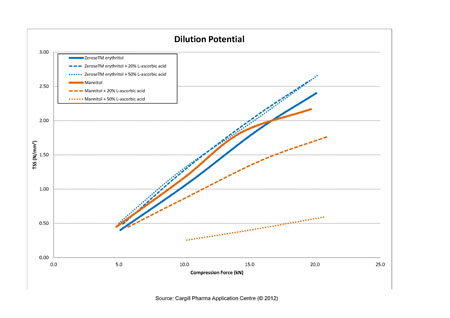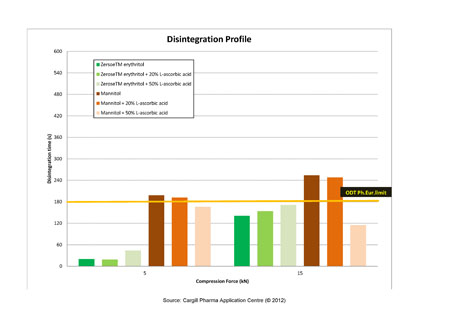Orally dispersible tablets are a dosage form in which taste and mouth feel are key. Liesbeth Meeus, Cargill Pharma & Personal Care Application Centre Leader, describes a pilot study looking at the use of Zerose erythritol in ODTs,
Excipients play an increasingly strategic role in the development of new pharma products by helping to deliver the actives and extend the life-span of existing products through novel formulations and dosage forms.1
Cargill Pharma recently announced results from a pilot study designed to assess the performance of Zerose erythritol as an orally dispersible tablet (ODT) excipient for unpalatable active ingredients compared with mannitol.
The following excipients were used:
- Zerose erythritol (Cargill)
- C*PharmIsoMaltidex, isomalt (Cargill)
- C*PharmMannidex, mannitol (Cargill)
- Magnesium stearate (Merck)
L-ascorbic acid (Prolabo) was used as an active ingredient.
Method: The hygroscopicity is measured by the moisture sorption analyser (CI Sorp). The adsorption of water by the excipients is measured by varying the relative humidity from 0% RH to 100% RH.
Powder formulation: The different excipients (and active ingredient) are wet granulated (with water) in the high shear granulator (Model Mi-Pro 500; Pro-C-ept). The free-flowing granules are blended with 1% magnesium stearate for three minutes at 28rpm (Model FGS+AR400E; Erweka).
Tabletting conditions: Round flat-faced tablets were produced from the granules and magnesium stearate blend on the rotary tableting press (Model 1200I; Fette). They had a surface of 1cm² and a target weight of 350mg. They were made at varying compression forces, from 5kN up to 20kN, and a tableting speed of 55rpm to obtain a complete profile.
Tablet testing: The following tests were performed on the tablets 24 hours after the tableting trials. Analyses of the tablets were carried out according to the methods described in the European Pharmacopoeia:
- For each compression force 10 tablets were analysed for hardness (H), thickness (T), diameter (D) and weight on a hardness tester (Model Multicheck V; Erweka). Mean values were calculated for all measurements. With these values the tensile strength (Ts) was calculated: Ts = 2H/TD. The tolerance for weight variation for uncoated 350mg tablets is 5%.
- For each compression force the disintegration time of six tablets in water at 37°C was measured in a disintegration tester (model ZT 73; Erweka) with disks. The disintegration time for dispersible tablets has to be below three minutes.
Results: Zerose erythritol is a zero-calorie, non-hygroscopic (Figure 1), non-cariogenic polyol with a high-level of digestive tolerance. The results obtained so far from the study using L-ascorbic acid (Vitamin C) as the active, Zerose erythritol as the excipient and C*PharmIso- Maltidex isomalt as the additional excipient, are striking.
There are three specific areas where Zerose erythritol outperforms mannitol, the current most widely used polyol excipient. They are dilution potential, disintegration profile and taste masking.
For example, Zerose erythritol’s dilution potential was shown by the study to be much higher when compared with mannitol under the same production conditions. With an addition of 10–50% of active ingredient, no significant loss of tablet quality is seen. For tablets made using mannitol (in ODTs), on the other hand, a decrease of more than 75% in hardness is seen for a formulation containing 50% of active ingredient (Figure 2).

Figure 2: Zerose erythritol outperforms mannitol on dilution potential
With regard to the disintegration profile, in tablets containing 10% Vitamin C and comparing Zerose erythritol with mannitol, variations in performance have been noted. The disintegration profile (even without the addition of a super disintegrant) was found in the study to be much better for Zerose erythritol tablets than for same formulations with the alternative excipient (Figure 3). As disintegration times are one of the key factors in ODTs, this is a real benefit.

Figure 3: Zerose erythritol outperforms mannitol on disintegration profile
In terms of taste masking, Zerose erythritol has well-documented properties relating to unpalatable compounds in food. This pilot study confirmed that the established taste-masking properties of Zerose erythritol as a food ingredient are just as effective with unpalatable pharma actives. Cargill’s internal taste panel was unanimous in its approval of the tablets produced containing Zerose erythritol. The tablets made with Zerose erythritol were much more positively received by participants compared with those with the widely used alternative polyol.
The current most widely used polyol excipient, mannitol, continues to have a role to play with ODTs. But where taste masking and a high dilution profile are important, Zerose erythritol has genuine and distinct advantages.
This pilot study is the latest development in a three-year programme during which Cargill Pharma has been developing Zerose erythritol as a pharma excipient for ODTs. Through ongoing research of this nature, conducted at its Pharma Application centre in Vilvoorde, Belgium, Cargill is able to extend its services beyond those of simply an ingredients supplier to those of a development partner capable of collaborating with customers to create successful new concepts.
A new patent application for the use of Zerose erythritol in ODTs has been filed.2 This complements two other pharmaceutical patent applications, of which one is already granted, covering granulation of Zerose with C*Pharm Sorbidex sorbitol and C*Pharm IsoMaltidex isomalt as a binder to create acceptable-tasting chewable tablets with moisture-insensitive and moisture-sensitive actives.
Cargill is now undertaking a similar pilot study with another active ingredient in place of Vitamin C as the unpalatable active, and will announce these results on completion.
Three particular problems have been solved by the use of Zerose erythritol as an excipient. It has made easier the creation of tablets of sufficient hardness for a given quantity of active pharmaceutical ingredients (APIs), which in practice means tablets can be smaller and thus more acceptable.
A superior disintegration profile has also been achieved without the need for a superdisintegrant, and the masking of unpalatable tastes associated with pharmaceutical actives has been achieved thanks to the taste-masking properties of Zerose erythritol, which means less need for flavourings.
These developments address the important and growing market for ODTs, which are often the most acceptable way to deliver APIs for older people, people with dysphagia, nausea, vomiting and motion sickness, children or people on the move.3,4 ODT dosage forms can be taken without water, which means they can be consumed anywhere.
References
1. Kline & Company: Business Process Management Consulting and Industry Market Research Reports
2. WO2010025796 A1 - Tabletting of Erythritol
3. SciPharm, D. Shukla, Mouth dissolving tablets II: An overview of evaluation techniqus p.327-341 (2009)
4. World Meeting on Pharmaceutics, Biopharmaceutics and Pharamceutical Technology, Preformulation study of fast melting tablets, L. Segale (2006)




